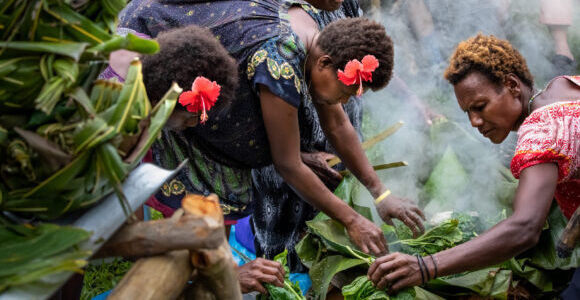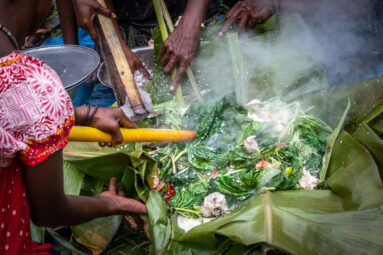David Soroda reflects on Papua New Guinea’s rich food heritage, from smoky and tender meat and root vegetables prepared in a mumu in the Highlands to fresh fish in coconut cream on the coast.

Women of East New Britain preparing a traditional dish cooked with hot stones and wrapped in leaves. Credit: iStock
As Papua New Guinea marked its 50th year of independence in September, the nation not only reflected on its political journey but also celebrated the vibrant tapestry of its cultural identity, none more deliciously than through its food. From the misty Highlands to the sun-drenched coastlines, PNG’s culinary landscape is a living archive of its people, traditions and the land itself.
This golden jubilee has been more than a milestone; it has been a feast. And for travellers flying into the heart of the Pacific, there’s no better time to explore the rich, diverse and deeply rooted food culture that defines the nation.
While tradition is the foundation, PNG’s culinary scene is also evolving. A new generation of chefs is reimagining local ingredients with global techniques.
PNG is home to over 800 languages and just as many unique culinary traditions. Each region, tribe and village has its own way of preparing food, often using ingredients sourced directly from the surrounding environment. This diversity is what makes PNG’s cuisine so compelling: it’s not just food; it’s storytelling on a plate.
In the Highlands, where the air is cool and the soil fertile, root vegetables like kaukau (sweet potato), taro, and yam are staples. These are often cooked in a traditional earth oven known as a mumu – a communal cooking method that involves hot stones, banana leaves and hours of slow steaming. The result is a smoky, tender and deeply flavourful meal that brings families and communities together.
On the coast and islands, seafood reigns supreme. Freshly caught fish, coconut cream, and tropical fruits like pawpaw, banana and pineapple are transformed into dishes that are both refreshing and hearty. Coconut-milk-based stews, grilled fish wrapped in banana leaves and tangy lime-marinated ceviche-style dishes showcase the coastal flair.
During the jubilee celebrations, communities across the country hosted large-scale mumu feasts, inviting locals and visitors to share in the experience.
In Port Moresby, there was a mumu festival in May, where chefs and elders from all 22 provinces prepared regional variations of the dish. They prepared everything from pork belly slow cooked with wild greens to chicken infused with ginger and lemongrass, all wrapped in the earthy aroma of banana leaves.
While tradition is the foundation, PNG’s culinary scene is also evolving. A new generation of chefs is reimagining local ingredients with global techniques, creating a fusion that’s both respectful and innovative.
At Tura Restaurant in Port Moresby, executive chef Lohia Vagi is leading the charge. His signature dish, smoked barramundi with taro gnocchi and coconut foam, is a tribute to his Motuan heritage and his training in European kitchens. “We’re not just preserving our food culture,” he says. “We’re elevating it.”
Other hotspots like Ela Beach Hotel’s Brasserie, The Stanley Hotel’s Silver Leaf, The Hilton’s Mumu and Rapala at the Crown Hotel are also showcasing PNG’s bounty with flair. Expect menus that feature wild river prawns, sago-crusted tuna, and desserts made with local cacao and vanilla.

A coastal wet mumu of aibika, chicken and coconut cream wrapped in banana leaves, ready to steam over hot stones. Credit: iStock
To truly understand PNG’s culinary heartbeat, one must visit its markets. The Gordons Market in Port Moresby, recently revitalised, is a sensory overload of colour, aroma and chatter. Here, women from the Highlands sell bundles of kaukau and pipit (a native sugarcane), while coastal vendors offer smoked fish and bundles of betel nut.
In Lae, the Main Market is famous for its fresh pineapples and the fiery local chilli known as daka. In Rabaul, you’ll find seafood so fresh it’s still wriggling, alongside exotic fruits like rambutan and mangosteen. These markets are more than shopping destinations, they’re cultural crossroads where food, language and tradition intersect.
One ingredient that unites many of PNG’s diverse regions is sago, a starch extracted from the sago palm. In the Sepik region, sago is life. It’s pounded, washed and cooked into pancakes or dumplings, often served with smoked fish or wild greens.
During the 50th anniversary year, the Sepik Sago Festival will return to Yanget village in the East Sepik on December 15 and 16 with even more fanfare.
Visitors can watch traditional sago processing demonstrations, taste dozens of sago-based dishes and witness the crocodile dances that honour the region’s spiritual connection to the river and its creatures.
No celebration is complete without a drink, and PNG has its own unique offerings. Locally brewed beers like South Pacific Lager and Niugini Ice are popular, but the real stars are the traditional beverages.
Kava, though more common in neighbouring Pacific nations, is enjoyed in some PNG communities. More widely consumed is kulau, young coconut water, often served straight from the shell. For something stronger, try PNG coffee, grown in the Highlands and considered among the best in the world. The Goroka Coffee Festival, held in September, offers tastings, barista competitions and cultural performances.
The PNG Tourism Promotion Authority, meanwhile, has launched a year-long campaign titled ‘Taste PNG: A Culinary Journey Through Time’. This initiative includes food trails, cooking classes and village homestays where travellers can learn to prepare traditional dishes.
Air Niugini has also joined the celebration by introducing a special in-flight menu featuring regional delicacies.
As PNG looks ahead, its culinary future is bright. Sustainability, food security and cultural preservation are at the forefront of national conversations. Young chefs are returning from overseas with new skills, farmers are embracing organic practices, and communities are finding pride in their food heritage.
This article was first published in the November 2025 – January 2026 issue of Paradise, the in-flight magazine of Air Niugini.









Speak Your Mind